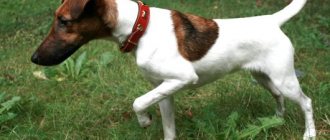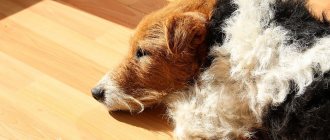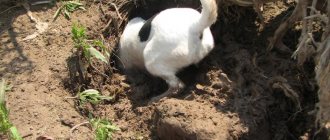| Origin: | Great Britain |
| Usage: | burrowing dog, companion |
| Color: | pure white, piebald with dark or orange spots |
| Dimensions: | 34-39 cm, 7-8 kg |
| Lifespan: | 12-16 years old |
In England, several centuries ago, a dog was born with the passion of a hunter, the soul of a watchman and the heart of a loyal friend. This is an impressive pet with a square body, columnar paws and a wire coat - the Wire Fox Terrier.
Breed characteristics
| Short description | |
| Origin: | Great Britain |
| Conditions of detention: | In the apartment |
| Purpose: | Hunting |
| Color: | The background tone is white, with spots of red or black on it; a combination of marks of both shades is also allowed |
| Wool length: | 2-4 cm |
| Adult dog size: | The height at the withers of males is no higher than 39 cm, ideal body weight is 8.25 kg. The exact indicators for females are not specified in the requirements, but they are slightly lower and lighter. |
| Average life expectancy: | 13-16 years old |
| Walk: | Twice a day, continuously |
| Physical activity needs: | High |
| Fédération Cynologique Internationale (FIC) classification: | Group No. 3 Terriers; Section No. 1 Large and medium terriers |
| Puppy price: | 10,000-30,000 rub. Pet class – 10-15,000 rubles. Breed class – 16-24,000 rubles. Show class – 25-30,000 rubles. |
Nutrition
Fox terriers are fed both self-prepared or raw foods, as well as dry store-bought food.
The diet includes:
- boiled and raw beef, lamb, turkey, offal;
- cottage cheese;
- vegetables, chopped fruits;
- cereal porridges except pea, semolina and pearl barley;
- boiled sea fish with previously removed bones.
Dogs starting from 10 months of age eat twice a day. The daily food intake includes 70% animal food and 30% plant food. Fruits and vegetables are included in the diet to replenish vitamins and minerals in the body. These same products, together with cereals, are a source of fiber that supports normal digestion and regular bowel movements.
To prevent excess weight gain, Fox Terriers are given fasting days on low-calorie vegetables and crackers. If it is not recommended to leave food remains in a visible place, then fresh water should be available at all times.
Before switching to dry food, consult the veterinarian observing the dog. The doctor will give advice on choosing a brand based on weight and health. To prevent your pet from later refusing ready-made food that is balanced in terms of the content of all necessary substances, you should not give it natural products at the same time.
The puppy food set includes:
- chopped raw meat in its pure form, boiled - as an additive to porridge;
- milk, cottage cheese, boiled yolk;
- cereal porridges, usually oatmeal;
- grated vegetables.
From three months, sinewy bones, sold in a pet store, are introduced into the diet. Boiled liver is given from six months. It would be a good idea to purchase a complex of vitamins, and your veterinarian will help you choose them.
Two-month-old puppies eat often (6 times) and little by little. As they grow, the number of feedings is reduced, increasing the portions. So for a six-month-old puppy three meals a day are enough, and from 9-10 months - two times.
You should not offer your dog food made from semi-finished products or meat and sausage products. These products contain large amounts of salt, synthetic preservatives, dyes, and flavor enhancers.
History of the origin of the species
It is believed that the ancestors of the representatives of the breed were turf dogs. When crossed with domestic dogs, they achieved offspring with excellent hunting skills. The first mentions of dogs of this type date back to the 17th century. The appearance of fox terriers of those times was very different from each other, the only thing they had in common was their excellent ability to catch burrowing animals - fox, badger, etc.
After the English aristocrats became interested in hunting and turned their attention to these animals, selection began to take into account not only working qualities, but also appearance. The dogs had to be small, compact, and have a noticeable color so that the hunter would not accidentally shoot the pet.
The photo shows a smooth-haired and a wire-haired terrier
Initially, the Wire Fox Terrier was often crossed with the Smooth Fox Terrier, and it was even believed that these species had a common origin. It was only in 1876 that the first breed standard was adopted, describing the main characteristics of dogs. After this, most clubs recognized the wire-haired dog as a separate species, although some still believe that it is only a variety of the fox terrier.
Purpose
The main purpose of Wire Fox Terriers is to hunt burrowing animals, namely foxes. "Fox" means "fox". During the First World War, this breed of dog showed itself as a brave defender of the fatherland, many were awarded medals. Dogs are truly fearless, brave, and capable of attacking larger animals. Now many people take them as companions.
Distinctive features
The FCI standard provides the following requirements for the dog's exterior:
- The head has an almost flat top of the skull, gradually tapering towards the nose. The feet and cheekbones are poorly developed, the area under the eyes is full. The skull is slightly sloping and has a slight difference in length with the muzzle.
- bite . The jaws are full-toothed and strong. The upper incisors are strictly vertical, overlapping the lower ones.
- The nose is exclusively black.
- eyes that are as close in shape to a circle as possible. Always dark, lively, small in size. They should not be set wide or high, and convex ones are also unacceptable.
- The neck is muscular, widens towards the shoulders, has no dewlap, and is dry. If you look at the dog from the side, you can notice its noticeable bend.
- The ears fit well to the temples and are directed straight forward. The shape is similar to the English letter “V”. They form a fold, the top line of which is always located above the line of the skull.
- The tail is strong, set high, carried vertically, never carried over the back. In the past, it was more often stopped by a third. The natural option is now allowed.
- The body is preferably square in shape, when the height at the withers and the length of the back are approximately equal. The body has strong bones and when standing it resembles a hunting horse. The absolutely flat back turns into a very short, barely convex loin. The sternum is not wide, but deep. Only the last ribs have good curvature and length.
- The legs are muscular, straight, and show no signs of weakness. The glenohumeral joint and withers are clearly defined. Shoulders of pronounced length, inclined. The elbows are always located at an angle of 90 degrees to the body. The hocks lie low and the knees cannot be turned out.
- The movements are straight, the legs move parallel to each other. The rear ones give a boost.
- The coat is very hard, wiry-like, with a shorter, softer undercoat underneath the awns. Longer hair is located on the jaws, legs, spine, sides and withers.
Breed diseases
On average, these small hunters live 15 years, naturally, if they eat well and receive the necessary care. But fox terriers have a number of hereditary diseases:
- epilepsy – the pathology is almost impossible to detect in a puppy, but can be traced in its pedigree;
- Perthes syndrome is a joint disease caused by poor circulation in the head of the tibia. The first symptoms appear by 4-6 months of age;
- myasthenia gravis – dysfunction of the musculoskeletal system;
- eye diseases - cataracts develop more often;
- diabetes – develops against the background of hormonal imbalances.
In addition, among representatives of the breed there are often individuals suffering from congenital deafness.
Photo of an adult dog
Photos of puppies
Features of character and behavior
This dog has the typical character of a terrier. The Fox Terrier is a real hunter, with all the attendant behavioral features.
Advantages
- Like all terriers, representatives of this breed are energetic, active, and always ready to play or work. They can run for a long time, fetch a ball, and participate in other activities, which certainly makes them excellent companions for older children.
- Curiosity and a lively mind allow Fox Terriers to quickly learn new commands.
- Attachment to the owner, the desire to receive praise from him, only help in training and education.
- Innate fearlessness and protective instincts make dogs good protectors. Dogs always keep a vigilant eye on strangers; when negative actions occur, they notify their owners about the intruder with a loud bark, and can rush to attack, regardless of the size of the opponent.
- These dogs are easy-going and will be happy to go with their owner on country walks. Fox Terriers will appreciate the freedom of relaxation, the opportunity to explore new territories and get acquainted with the local fauna. English hunters will survive moving to a new home or city well.
Flaws
- The typical stubbornness of terriers has not escaped representatives of this breed. If they don't feel like it, they can ignore commands, cheat, and get distracted. It is important to find the right approach to your pet and start training from a very early age.
- The strong instinct of the hunter makes it difficult to keep such a pet with other animals. Most likely, the fox terrier will perceive cats, ferrets, birds, and hamsters as game worthy of pursuit. In addition, the dog can start a fight with other dogs, especially of the same sex.
- Due to the possible awakening of the hunter's instinct, it is not recommended to walk the dog without a leash ; in the heat of pursuit, it may not hear the owner's call.
- It is also worth noting that wire fox terriers are prone to running away in principle , not only when walking, but also from the backyard.
- Dogs of this breed love to dig the ground, which can cause trouble for flower beds and beds . Also, their characteristic shrill voice, which they like to demonstrate, can provoke conflicts with neighbors.
- Despite the positive attitude towards children, the dog will not tolerate rough treatment or grabbing the fur, so it is not advisable for a Fox to live in a family with children.
Description of the Wire Fox Terrier
Like every specially bred breed, Wire Fox Terriers have distinctive features. They affect not only appearance, but also character.
Appearance and characteristics
The main purpose of the breed is pursuit of prey and hunting. They immediately determine the location of the holes, climb inside and strangle the victim, closing their powerful jaws on the neck. The special physique allows you to bear heavy loads. The Wire Fox Terrier has a strong, dry body. The muscles are well developed, the back is strong, the limbs are proportional to the body and straight. The skull is flat, tapering towards the nose. The line of transition from the forehead to the nose is weakly expressed. Ideally, the length of the muzzle is equal to the skull. The ears are set quite close to each other, triangular in shape, and the tips droop. The bite is scissor, the jaws fit tightly together. The eyes are round and dark. The long and muscular neck widens closer to the shoulder line. The chest is wide and deep. The tail is set high and straight.
Photo from Instagram account joy_foxterrier
Photo from Instagram account forties_face_flossy
An adult male grows up to 39 cm at the withers and weighs 7-9 kg. Bitches differ in size: weight often does not exceed 8 kg, and height reaches 37 cm. Life expectancy ranges from 11 to 14 years.
The name of the breed determines the type of coat of the animal: hard in structure, wiry, wavy (not curly). On the ribs, back and limbs it is so dense that, spreading it, the owner will not be able to see the skin. The length varies depending on the season and climate. The undercoat, which keeps the dog warm in winter, is short and soft. Color - tricolor. The main color is white, and black and reddish-brown spots are scattered throughout the rest of the body.
Character
Getting a dog is recommended only for those who are endowed with nerves of steel and limitless patience. After reading the description of the character of the Wire Fox Terrier breed, everyone will be able to determine the possibility of keeping an extraordinary four-legged friend.
They are excitable, cheerful, energetic, which allows them to constantly play. They will be an excellent companion for lovers of long walks and an active lifestyle. Long loneliness encourages many pranks that are difficult to tolerate. Excessive and quite loud barking can annoy owners and neighbors. Many may notice a habit of digging. It doesn’t matter if it happens on the street or at home. When going to work for the whole day, you should strictly limit the dog’s ability to move around the apartment. Otherwise, when you come home, you may expect a lot of unpleasant surprises and the dog may be satisfied with what is happening.
Photo from Wikipedia website
Despite their hunting disposition, they get along well with children and take an active part in games. But you shouldn’t leave a child alone with your beloved pet - they can bite, defending themselves from careless movements. They can also get along with other animals, but the genes may not express themselves in the best way. Therefore, carefully consider the possible neighborhood.
Important! Males are more prone to aggressive behavior.
Care and maintenance
The Wirehaired Terrier does not shed, but its coat requires timely trimming. There are usually no problems with claws and teeth, but they also require care. It is necessary to inspect your pet's paws monthly and, if necessary, remove the overgrown part of the nail plate with a nail clipper. Teeth need brushing 1-2 times a week.
Foxes' ears are closed and not ventilated, which creates conditions for inflammation. Also, the appearance of a tick will not be immediately noticeable. Therefore, the ears must be examined 1-2 times a week and cleaned if necessary. Monitoring for the presence of mites in the sink after trips to nature is required.
A dog's eyes need to be checked weekly. If discharge or inflammation is detected, it is necessary to rinse the organ with chamomile infusion. To do this, moisten a cotton pad in liquid and move it from the outer corner of the eye to the inner.
Nutrition
Representatives of the breed love to eat, usually an active lifestyle helps to burn extra calories, but it is better not to overfeed your pet and not indulge in extra treats. You can offer your fox food natural or ready-made professional varieties. Both options are acceptable, and the choice depends on the preferences of the owner and the well-being of the pet.
Natural nutrition, first of all, involves feeding meat and offal. In this case, you need to choose low-fat varieties, because... an excess of this component harms the pet’s gastrointestinal tract. In addition to meat, the diet should include cereals such as buckwheat and rice, as well as the following products:
- vegetables;
- fermented milk products, cheese, cottage cheese;
- unsweetened fruits;
- eggs;
- sea fish.
The last product on the list is served only boiled and after all bones have been removed. Eggs can be fed 1-2 times a week.
You should not give your fox terrier chocolate, smoked meats, bones, pickled, fried, spicy or over-salted foods.
Among professional foods, you can purchase both dry and canned options. In any case, these should be brands of at least premium class, and better yet, super-premium or holistic. It is advisable to choose options labeled “for active breeds.”
The frequency of feeding depends on the age of the pet. An adult dog over 10 months old is given food 2 times a day. When feeding babies, you should adhere to the following scheme:
| Age, months | Number of meals, day |
| 2-4 | 5 |
| 4-6 | 4 |
| 6-10 | 3 |
Health
The Wire Fox Terrier is a healthy dog that usually lives a long life. However, some representatives may exhibit breed-specific diseases.
Vaccinations
Vaccination allows the fox terrier to gain immunity against the most common and dangerous diseases. A week before vaccination, regardless of age, the pet is treated for helminths. The first procedures are carried out according to the following scheme:
- 8-9 weeks – vaccination with a drug labeled DHPPiL;
- 12 weeks – re-vaccination with the introduction of medicine with code DHPPiL + R.
Both after the first and second procedures, the puppies are quarantined for 2 weeks . At this time, the baby should not be taken outside, and his condition should also be monitored. If the temperature rises, vomiting or loose stools appear, the pet should be taken to the veterinarian. Adult dogs are vaccinated once a year.
Diseases that vaccination can protect against:
- plague;
- coronavirus;
- rabies;
- parainfluenza;
- hepatitis;
- trichophytosis;
- parvovirus enteritis;
- leptospirosis.
Important article on the topic: “Everything you need to know about dog vaccinations.”
Diseases
The Wire Fox Terrier is in fairly good health. However, representatives of the breed may develop the following diseases:
- Cataract. This disease leads to a gradual decrease in visual function due to impaired transparency of the lens. The eye looks grayish-blue and cloudy.
- Distichiasis. Incorrect growth of eyelashes, which leads to injury to the surface of the eye, inflammation, and pain.
- Diabetes. It involves decreased production of insulin by the body, which results in high levels of glucose in the blood.
- Epilepsy. Due to congenital disorders of brain functioning, the dog experiences convulsive seizures.
- Perthes disease. It manifests itself in necrosis of the femoral head, which leads to lameness, pain when walking, and poor joint mobility.
- Myasthenia. More often it is a congenital problem and affects several puppies from a litter at once. Due to a lack of acetylcholine, the transmission of nerve impulses to cells is disrupted, resulting in weakness of individual muscle groups.
- Hearing problems.
Walk
You shouldn’t get a Wire Fox Terrier if you don’t have time to give it a full walk. The pet will use unspent energy to destroy the home environment. Also, in the absence of a walk, the dog will bark and howl, which can provoke a conflict with neighbors.
These dogs need long, active walks that involve running, jumping, and fetching a ball. Accompanying the owner on roller skates is a good idea, but you should make sure that there is no transport on the route. Dogs will be happy to participate in all types of dog activities, for example, canicross, agility, frisbee, freestyle.
Grooming
Representatives of the breed do not shed, but require trimming. This concept appeared in England in the last century. During the procedure, dead hair is plucked, a kind of “artificial shedding” occurs, which creates conditions for the rapid growth of new hair.
- It is better to teach trimming from a very early age, at 1.5-2 months, periodically lifting the baby onto a stool or table for a few minutes, then gradually combing and plucking the hair.
- The procedure can be of a hygienic nature, in which case it is indicated for all wire fox terriers without exception, or it can be an exhibition procedure, which is necessary only for pets with show prospects.
- For the first time, a puppy can be fully trimmed at 4-5 months, when the “adult” coat appears.
To carry out the manipulations you will need:
- Trimming knife (trimming) of medium and small size. The first is necessary for treating the back, neck, sides, hind limbs and back of the head. Small is used on the cheeks, ears, chest, inner thighs.
- fine comb.
Some owners use scissors and a clipper, but it is noted that with this approach the wool becomes soft, fluffy, and “cotton-like” in structure.” In addition, the color of the spots becomes duller.
When processing hair, the tufts are clamped between the thumb and the trimming grooves, then carefully plucked out. During the first procedures, you can use a knife as a comb, combing the baby’s fur, gradually accustoming it to the effect.
During hygienic trimming, the cover is pinched as much as possible on the neck, chest, back, sides, and cheeks . The ears are processed on both sides. The belly and hind legs need less treatment and a more careful approach, because... the procedure may be unpleasant for the pet. Only tufts of hair that have grown unevenly are removed from the limbs and muzzle with your fingers; the rest is combed well every day.
The process is repeated 3-4 times a year, but the hair on the paws between the toes is carefully removed or trimmed once a month. This is especially important in winter to prevent snow accumulation.
Exhibition preparation takes longer and takes place in several stages:
| Part of the body | Treatment | Time until the exhibition |
| Neck, back | The cover is briefly plucked until it is almost smooth. | 8-10 weeks |
| Throat | Just like the neck and back. | 2-3 weeks |
| Breast | The coat is combed to a standing position, and the back part is short plucked to create a smooth transition to the belly. | 1-1.5 months |
| Hips | The hair is removed up to the hock joint, and the surface is processed on both sides. | 4-6 weeks |
| Front legs | The coat is combed upward and not trimmed. It is desirable to create the effect of “column-shaped” limbs. | Daily |
| Paws | It is given a rounded shape so that the claws are visible. | 3-5 weeks (adjustment is possible 10 days in advance) |
| Ears | Shortly removed on both sides | 3 weeks-1 month. (inner side – additional 1 week). |
| Tail | Remove any loose hair from both sides, it should look strong and thick. If the tail is short, you can leave an elongated cover at the end. | 1-1.5 months |
| Forehead | The cover is removed until smooth. | 3-4 weeks |
| Cheeks | Trimming. | 10 days |
| Beard | It is combed towards the nose; it should not be wider than the muzzle itself. Individual long hairs are removed. | Daily |
| Shoulders | The cover is briefly removed so that the relief is clearly visible. | 2 weeks |
| Sides | Trimmed until smooth. | 6-8 weeks |
| Metatarsus | Comb, only long and individually protruding strands are removed. | 10 days |
Dogs of this breed are rarely bathed, only when they are very dirty . Before the exhibition, the procedure is carried out no later than a week in advance, after which the wool is dried, preventing it from becoming disheveled. Paws can be washed under running water after each walk.
Mating
Mating is permitted for dogs with pedigree and show scores sufficient for breeding . Also, both parents must be healthy, vaccinated, and treated for helminths. Only if these conditions are met can one guarantee the production of offspring that are free from diseases and also conform to the breed’s conformation.
A suitable pair can be found in the kennel club in which the pet belongs. In this case, parents must reach the age of 2 years , because Early matings can weaken the health of the female and also produce weak offspring. Future parents are introduced to the male's territory and allowed to play first. Mating must be repeated 1-2 more times with a break of a day.
Read a detailed article on the topic: “Everything you need to know about breeding dogs: appropriate age, what to do if it doesn’t work out, rules and tips.”
Health
Wire Fox Terriers rarely suffer from acquired pathologies, but are prone to a number of genetic defects. Therefore, buying healthy puppies is the key to the health and longevity of your pet.
If pets are free of hereditary defects and congenital diseases, they live up to 16 years.
Diseases
The Wire Fox is prone to:
- epilepsy;
- congenital deafness - more common in dogs with a pure white color;
- skin diseases - eczema, dermatitis;
- diabetes mellitus;
- cataracts;
- double row of eyelashes.
The most common acquired pathologies in Wire Fox Terriers are food allergies and obesity. Both diseases develop due to improper feeding. And over time, extra pounds affect the condition of the joints and cardiovascular system.
Disease Prevention
Wire Fox Terriers must:
- give deworming tablets once every 3 months;
- carry out antiparasitic treatment: from spring to autumn every month, in winter - once a season;
- in spring, summer and autumn, wear a collar against ticks, fleas, and lice;
- They are vaccinated against rabies, canine distemper, hepatitis, parvovirosis, and leptospirosis.
Key points in training
Fox Terriers have an excellent mind, they are inquisitive and active. Combined with the desire to please the owner, this creates an excellent background for education and training. But you need to take into account that such dogs are stubborn and willful, they can try to ignore commands and do only what interests them.
- With the right approach, you can raise a well-mannered and trained animal. To do this, you need to start classes from the moment the baby Fox appears in the house.
- Short-term exercises, with frequent repetitions, taking place in a playful way are the ideal way to interact with the dog.
- In this case, it is necessary to ensure the execution of the command given by the owner.
- Reinforcement is best done with praise and treats, because... Representatives of the breed love to eat delicious food. Cruelty and brute force will not help create a suitable atmosphere for training, but will only turn your pet against training.
Properly organized education will allow you to master not only the basic set of commands, but also to participate in obedience competitions. Wire Fox Terriers can be involved in hunting training or coursing.
Read about how to properly train a dog in the article: “Training a puppy: effective methods from dog handlers, learning commands at home.”
Historical reference
It will no longer be possible to determine the exact age of the breed group of burrowing dogs. It is known that terriers descended from the dogs of the Ash period, that is, from the ancient Spitz. The species group lived next to people even before our era, some of the dogs received the “qualification” of guards and shepherds, the other part was used in hunting. Naturally, after the invention of firearms, the demand for burrowing dogs subsided, and the early gundog groups were held in high esteem. This continued until the development of the fur business began.
It must be noted that in England, fox hunting did not always have a financial motivation. In some rocky regions, the population of red-haired leprechauns exceeded the number of rats. Even in those days, people knew about deadly diseases. Rats were feared because of the plague, and foxes because of rabies. Burrowing dogs, that is, terriers, came to people’s aid in exterminating “pests.”
This is interesting! Terrier is literally translated as a burrowing dog, Fox is a fox. The Fox Terrier is a fox burrowing dog.
In addition to diseases, predators and rodents destroyed food supplies and poultry. Today, a dozen dead chickens will only cause disappointment to the owner. During the formation of terriers, poultry was expensive and a predator could literally ruin a farmer. The concept of hunger was not alien to people. Many commoners could not keep large dogs for financial reasons, but small four-legged dogs that helped with housework were always at a premium. So, little by little, the species group developed and was divided along regional lines, until fox hunting became a ritual.
The British elevated hunting to the “rank” of a national holiday , and dogs, as an integral attribute, attracted more and more attention from the nobility. One of the respected hunters noted in history was Pastor John Russell. The man has been breeding burrowing dogs all his life, trying to improve their working and external characteristics to suit his own taste. The result of his work was the Jack Russell Terrier breed, but in the history of Foxes Russell is not in last place. The fact is that the priest not only bred dogs, he dictated fashion and carried out “marketing work” to popularize the breeds. Since the pastor is a respected person, more and more hunters were drawn to John’s house, and there was only one goal - to acquire Russell’s dog.
This is interesting! The “rise” of their smooth-haired counterparts also left an imprint on the popularity of wire-haired foxes, at least they became known to the general public. By analogy with the development of many English breeds, in the early stages, no special attention was paid to the dogs’ exterior.
The start of planned breeding work dates back to the beginning of the 18th century, with the founding of the first breed club. It should be noted that all significant breeders were avid hunters and bred dogs “for themselves,” but adhering to a single course. Foxes are perhaps one of the few breeds when working on which the experts were not “greedy” and willingly shared both their experience and producers.
By the middle of the 19th century, breeders were guided by a “fixed” breed standard (without taking into account the type of coat) and actively resorted to inbreeding. By 1862, Foxes were recognized as a separate breed , that is, they were finally separated from their ancestors. After a specialized exhibition, where different four-legged animals were shown in one ring, it was decided to divide the dogs according to the length of their coat.
This is interesting! In the 1860s, Fox Terriers were shown in one class, then divided into groups by gender and only then by coat type.
How to buy and choose a puppy
In order to purchase a healthy baby wire fox terrier with all the characteristics of the breed, you need to contact a nursery. It is worth studying the list of available establishments specializing in breeding representatives of the breed, checking their registration and reading reviews. It is also necessary to review the achievements of nursery graduates, information about available sires and expected litters.
A good way to meet a professional breeder of your future pet is to attend breed exhibitions. It is there that you will be able to see the Foxes of a particular breeder live, hear the judges’ opinions about them, and get acquainted with their character, health and training.
When a suitable kennel has been chosen, it is worth deciding what the puppy is needed for - as a companion for games or hunting, for breeding or participation in exhibitions. Based on this criterion, the breeder will help you choose a pet.
When visiting a nursery, you need to familiarize yourself with the pedigrees of the parents, information about mating, check the baby’s metric and brand, and also evaluate his behavior. The puppy should be active, inquisitive, and not showing signs of anxiety or aggression when approached by strangers or making noise.
After the purchase, the breeder must give the new owner a birth certificate, which must later be replaced with a pedigree, and a veterinary passport for the baby. A pet older than 45 days already has a brand.
The Wire Fox Terrier is an excellent companion for an active and energetic family. He will be happy to participate in games, competitions, and trips to nature. Its perky character, compact size and lack of shedding make it an excellent pet for apartment living.
Differences from Jack Russell Terriers
The Jack Russell Terrier is a fairly young, unformed breed. In terms of appearance, they differ from fox terriers in size and character. Russells are slightly smaller and more docile.
- The Fox Terrier is a generally recognized fighter and hunter. This is a faithful friend and protector of its owner, a tireless companion of people who respect an active lifestyle.
- Jack Russell Terriers are considered as ornamental animals. But since the breed is in a state of improvement, unbalanced individuals with an unstable psyche are often encountered. You should be careful when choosing a puppy; preference should be given to large nurseries.
Terriers have a common character trait - an insatiable passion for hunting. The desire to catch up with prey was inherited from their distant ancestors. Fox Terriers, along with developed hunting qualities, are capable of becoming loyal friends, brave protectors and loving companions for their owners.











